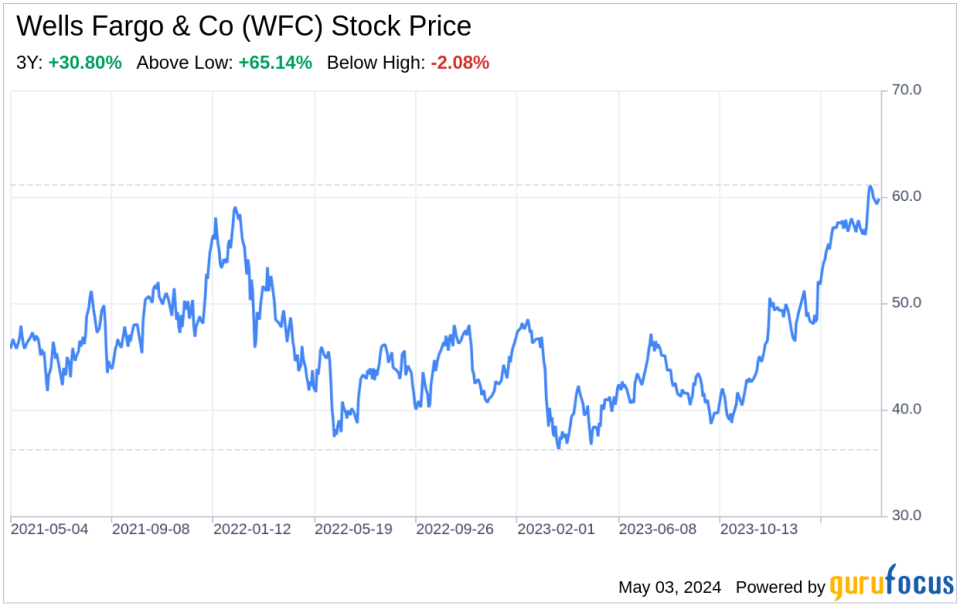Decoding Wells Fargo & Co (WFC): A Strategic SWOT Insight
Wells Fargo & Co (NYSE:WFC) faces a challenging interest rate environment impacting net interest income.
Despite a strong capital position, regulatory scrutiny remains a significant concern.
Opportunities for growth in digital banking and wealth management sectors.
Threats include competitive pressures and potential economic downturns.
Wells Fargo & Co (NYSE:WFC), a leading financial institution with a focus on the U.S. market, reported its first quarter results on May 2, 2024, through a 10-Q filing. With approximately $1.9 trillion in assets, the company operates through four primary segments: consumer banking, commercial banking, corporate and investment banking, and wealth and investment management. The latest financial tables reveal a mixed performance, with a 7% decrease in net income compared to the previous year, primarily due to an 8% decline in net interest income. However, noninterest income showed a robust 17% increase, signaling a potential shift in revenue sources. This SWOT analysis aims to dissect the strengths, weaknesses, opportunities, and threats as presented in the 10-Q filing, providing investors with a comprehensive understanding of Wells Fargo's current position and future prospects.

Strengths
Robust Capital and Liquidity Position: Wells Fargo & Co (NYSE:WFC) maintains a strong capital position, with total equity of $182.7 billion as of March 31, 2024. The company's Common Equity Tier 1 (CET1) ratio stands at 11.19%, well above the regulatory minimum, indicating a robust buffer against potential losses. Additionally, the liquidity coverage ratio (LCR) of 126% surpasses the required 100%, showcasing the company's ability to meet short-term obligations even under stress scenarios. This financial resilience is a testament to Wells Fargo's prudent risk management and capital allocation strategies, which are crucial for maintaining investor confidence and ensuring long-term stability.
Diversified Revenue Streams: Wells Fargo's diversified business model, with a mix of net interest income and noninterest income, provides a balanced source of revenue. The increase in noninterest income by 17% in the first quarter of 2024, driven by higher treasury management fees, investment advisory fees, and trading gains, demonstrates the company's ability to capitalize on varied market conditions and client needs. This diversification helps mitigate the impact of fluctuating interest rates and enhances the company's ability to generate consistent revenue across its operating segments.
Weaknesses
Declining Net Interest Income: The 8% decline in net interest income reflects the challenges Wells Fargo & Co (NYSE:WFC) faces in a rising interest rate environment. The cost of interest-bearing deposits and long-term debt has increased, outpacing the earnings from interest-earning assets. This compression in net interest margin could signal underlying vulnerabilities in the bank's traditional lending business and may necessitate a strategic reassessment of interest rate risk management and loan pricing strategies to safeguard profitability.
Regulatory and Legal Challenges: Wells Fargo continues to grapple with the consequences of past regulatory issues, including consent orders and other actions that require significant changes to business operations and risk management practices. The ongoing need to address these regulatory concerns consumes resources and management attention, potentially diverting focus from growth initiatives and innovation. Moreover, the potential for additional fines or business restrictions poses a persistent risk to the company's reputation and financial performance.
Opportunities
Digital Banking Expansion: The financial industry's shift towards digital banking presents significant opportunities for Wells Fargo & Co (NYSE:WFC) to enhance customer experience, streamline operations, and reduce costs. By investing in technology and innovation, the company can attract tech-savvy customers, improve client retention, and compete effectively with fintech challengers. The digital transformation also opens up new revenue channels through personalized financial products and services, leveraging data analytics and artificial intelligence.
Growth in Wealth and Investment Management: Wells Fargo's wealth and investment management segment has shown resilience, with increased fees reflecting higher market valuations. As the population ages and the demand for retirement planning and wealth management services grows, Wells Fargo is well-positioned to capture a larger market share. Expanding its offerings in this segment can lead to a more stable and predictable revenue stream, countering the volatility in other areas of the business.
Threats
Competitive Landscape: The banking industry is highly competitive, with traditional banks, credit unions, and emerging fintech companies vying for market share. Wells Fargo & Co (NYSE:WFC) must continuously innovate and adapt to maintain its competitive edge, particularly in areas such as digital banking services, where customer expectations are rapidly evolving. Failure to keep pace with technological advancements and changing consumer preferences could result in lost business and reduced profitability.
Economic Uncertainty: Economic downturns and market volatility can adversely affect Wells Fargo's business operations. Credit quality may deteriorate during economic contractions, leading to higher loan defaults and provisions for credit losses. Additionally, uncertainty in the economic outlook can dampen consumer and business sentiment, reducing demand for loans and other financial services. Wells Fargo must remain vigilant and proactive in managing credit risk and adjusting its business strategies to navigate these macroeconomic challenges.
In conclusion, Wells Fargo & Co (NYSE:WFC) exhibits a strong capital and liquidity position, with a diversified revenue model that provides stability in a challenging financial landscape. However, the company faces headwinds from declining net interest income and ongoing regulatory scrutiny. Opportunities for growth lie in the digital banking sphere and wealth management services, while threats from a competitive market and economic uncertainty loom. Investors should weigh these factors carefully when considering Wells Fargo's strategic direction and potential for long-term success.
This article, generated by GuruFocus, is designed to provide general insights and is not tailored financial advice. Our commentary is rooted in historical data and analyst projections, utilizing an impartial methodology, and is not intended to serve as specific investment guidance. It does not formulate a recommendation to purchase or divest any stock and does not consider individual investment objectives or financial circumstances. Our objective is to deliver long-term, fundamental data-driven analysis. Be aware that our analysis might not incorporate the most recent, price-sensitive company announcements or qualitative information. GuruFocus holds no position in the stocks mentioned herein.
This article first appeared on GuruFocus.

 Yahoo Finance
Yahoo Finance 